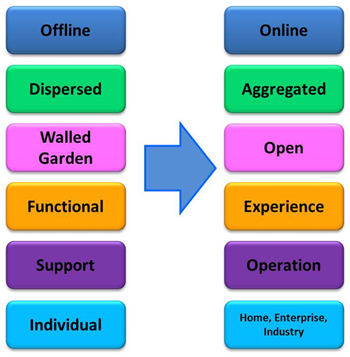To thrive in the Internet age, operators must transform themselves from 'communications service providers' into 'digital service providers.'

The Internet has had a profound impact on how services are consumed and delivered, with traditional models no longer providing adequate revenue streams for operators. Additionally, strong competition from non-traditional providers, such as IT and software companies, is forcing operators to reexamine their business models and service offerings in order to remain competitive. As such, operators are embracing a more open industry value chain -- one that fosters the integration of capabilities across borders and across platforms to form an ecosystem that can scale globally, compete globally and provide global partner innovation.
In order to benefit from this open industry value chain, operators must transform themselves from "communications service providers" into "digital service providers." A key element of this transformation is the implementation of a service delivery platform (SDP) that can accelerate the creation and delivery of new and innovative digital services such as IoT services, hosted cloud services and data monetization -- to name only a few -- that will drive future revenue growth.
Figure 1: Evolution of Services 
The digital SDP typically supports end-to-end business operation services such as distribution, aggregation, monetization and operations, allowing operators to better monetize their own digital assets while building a profitable digital value chain. Additionally, when integrated with assets from external channels such as the web and social media, an operator is able to aggregate and distribute ready-to-go global digital services and content such as digital music, mobile games, video, open APIs, traffic monetization, B2B cloud and M2M from best-of-breed partners across various domains.
This ecosystem enables operators to create and offer digital service malls and storefronts, digital service templates and branded digital marketplaces to support a variety of B2B and B2C services, applications and business models at both a local and global level. Furthermore, this ecosystem bridges the requirements of digital content providers and e-commerce merchants with the telecom operators' own assets (such as authentication and billing channels) to provide more efficient and safe transactions for third-party partners.
With digital resources aggregated into a single place and strategically located hosting centers, partners can integrate new ideas and technologies simply and quickly -- allowing operators to rapidly facilitate the launch of more compelling and diversified digital products. This results in increased revenues, increased customer loyalty and service experience. Other key benefits of this open digital services ecosystem include reduced service time to market including reduced implementation and integration costs resulting in a lower total cost of ownership.
Furthermore, when combined with big data analytics, the digital SDP can become a key competitive advantage for digital service providers -- providing multi-dimensional insight that positively impacts the business model, decision-making process and user experience, allowing for smarter business planning and innovation.
By embracing a more open digital value chain, operators are able to monetize their own network and user assets, while creating more value in a vastly expanded market landscape.
— Teresa Mastrangelo, Senior Analyst, Heavy Reading
This blog is sponsored by Huawei.
About the Author(s)
You May Also Like











